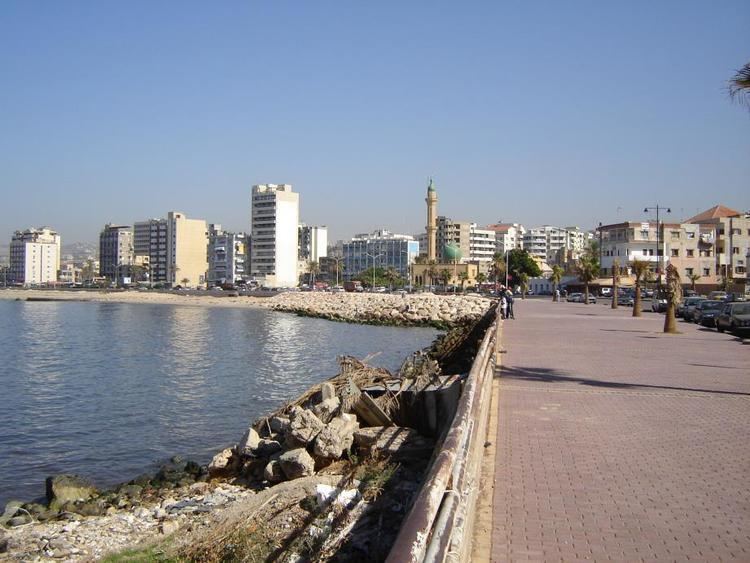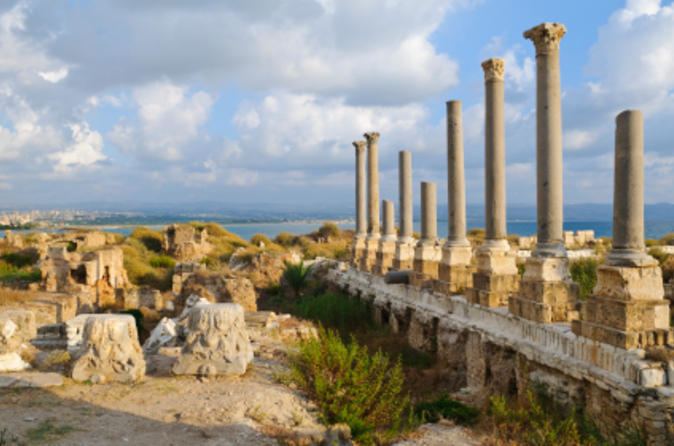Country Area 3 sq mi | District Sidon District Governor South Governorate Population 80,000 | |
Sidon or Saida (Arabic: ?,Arabic: ?, Sayda; Phoenician: , Sydwn; Biblical Hebrew: ???????, Sidon; Greek: ; Latin: ; Turkish: ) is the third-largest city in Lebanon. It is located in the South Governorate of Lebanon, on the Mediterranean coast, about 40 kilometres (25 miles) north of Tyre and 40 km (25 miles) south of the capital Beirut. In Genesis, Sidon is a son of Canaan, a grandson of Noah. Its name coincides with the modern Arabic word for fishery.
Contents
Map of Sidon
History
Sidon (whose name in classical Arabic is: ???????? (Saydoon)) has been inhabited since very early in prehistory. The archaeological site of Sidon II shows a lithic assemblage dating to the Acheulean, whilst finds at Sidon III include a Heavy Neolithic assemblage suggested to date just prior to the invention of pottery. It was one of the most important Phoenician cities, and may have been the oldest. From here, and other ports, a great Mediterranean commercial empire was founded. Homer praised the skill of its craftsmen in producing glass, purple dyes, and its womens skill at the art of embroidery. It was also from here that a colonizing party went to found the city of Tyre. Tyre also grew into a great city, and in subsequent years there was competition between the two, each claiming to be the metropolis (Mother City) of Phoenicia. Glass manufacturing, Sidons most important enterprise in the Phoenician era, was conducted on a vast scale, and the production of purple dye was almost as important. The small shell of the Murex trunculus was broken in order to extract the pigment that was so rare it became the mark of royalty.

In AD 1855, the sarcophagus of King Eshmun’azar II was discovered. From a Phoenician inscription on its lid, it appears that he was a "king of the Sidonians," probably in the 5th century BC, and that his mother was a priestess of ‘Ashtart, "the goddess of the Sidonians." In this inscription the gods Eshmun and Ba‘al Sidon Lord of Sidon (who may or may not be the same) are mentioned as chief gods of the Sidonians. ‘Ashtart is entitled ‘Ashtart-Shem-Ba‘al ‘Ashtart the name of the Lord, a title also found in an Ugaritic text.
In the years before Christianity, Sidon had many conquerors: Assyrians, Babylonians, Egyptians, Greeks, and finally Romans. Herod the Great visited Sidon. Both Jesus and Saint Paul are said to have visited it too (see Biblical Sidon below). The city was eventually conquered by the Arabs and then by the Ottoman Turks.
Like other Phoenician city-states, Sidon suffered from a succession of conquerors. At the end of the Persian era in 351 BC, it was invaded by the emperor Artaxerxes III and then by Alexander the Great in 333 BC when the Hellenistic era of Sidon began. Under the successors of Alexander, it enjoyed relative autonomy and organized games and competitions in which the greatest athletes of the region participated. In the Necropolis of Sidon, important finds such as the Alexander Sarcophagus, the Lycian tomb and the Sarcophagus of the Crying Women were discovered, which are now on display at the Archaeological Museum of Istanbul.
When Sidon fell under Roman domination, it continued to mint its own silver coins. The Romans also built a theater and other major monuments in the city. In the reign of Elagabalus a Roman colony was established there, and was given the name of Colonia Aurelia Pia Sidon. During the Byzantine period, when the great earthquake of AD 551 destroyed most of the cities of Phoenice, Beiruts School of Law took refuge in Sidon. The town continued quietly for the next century, until it was conquered by the Arabs in AD 636.
On 4 December 1110 Sidon was captured, a decade after the First Crusade, by King Baldwin I of Jerusalem and King Sigurd I of Norway. It then became the centre of the Lordship of Sidon, an important lordship in the Kingdom of Jerusalem. Saladin captured it from the Crusaders in 1187, but German Crusaders restored it to Christian control in the Crusade of 1197. It would remain an important Crusader stronghold until it was finally destroyed by the Saracens in 1249. In 1260 it was again destroyed by the Mongols. The remains of the original walls are still visible.
After Sidon came under Ottoman Turkish rule in the early 16th century, it became the capital of the Sidon Eyalet (province) and regained a great deal of its earlier commercial importance. After World War I it became part of the French Mandate of Lebanon. During World War II the city, together with the rest of Lebanon, was captured by British forces fighting against the Vichy French, and following the war it became a major city of independent Lebanon.
Following the Palestinian exodus in 1948, a considerable number of Palestinian refugees arrived in Sidon, as in other Lebanese cities, and were settled at the large refugee camps of Ein el-Hilweh and Mieh Mieh. At first these consisted of enormous rows of tents, but gradually houses were constructed. The refugee camps constituted de facto neighborhoods of Sidon, but had a separate legal and political status which made them into a kind of enclaves. At the same time, the remaining Jews of the city fled, and the Jewish cemetery fell into disrepair, threatened by coastal erosion.
Main sights
Architecture and landscape
In general, the architectural spaces of the old part of the city, with its antique, medieval and Ottoman quarters, are impressive, and are ranked as world heritage. It is adorned with various examples of great architectural legacies since antiquity. This is the case despite the fact that its buildings and alleyways are neglected, and require monumental renovations and organised efforts to prevent them from falling into further ruin. Some international funds were allocated to sponsor the facelifting of certain public spaces and old squares with the provision if minimal infrastructure. There are also individual initiatives to restore specific neighbourhoods as pioneered by the Audi Foundation and its elegantly rehabilitated old soap factory, now turned into a museum. The same applies to the renewal of the Debbane Ottoman mansion or villa, which was originally linked to the Hammoud family trust and was even occupied by a branch of the aristocratic Abaza family towards the end of the 19th century. The old city has great architectural potentials that remain underdeveloped. It has qualities that can put it on par with the old quarters of Antibes if its architecture becomes safeguarded and protected as well as promoted for quality life-styles. Sidon can learn from more modest yet successful examples in Lebanon itself, such as the restoration and adaptive re-use of the old quarters of Byblos and its small seaport entourage, or to be inspired in a humbler scale by the development of Downtown Beirut.
The modern city of Sidon that extends outside the walls of the medieval quarters is generally chaotic, deprived of any notable aesthetics, built with inexpensive material, and lacking in any form of urban planning. There are some minor exceptions to this at the level of individual buildings, especially those erected in the 1950s to the 1960s, in addition to a small number of mosques, commercial malls and villas or buildings designed by proper architects or up-market developers. The sprawl in the built environment has disfigured the cityscape and the landscape around it. Ugly buildings and terrible parking lots replaced the great citrus orchards that once surrounded Sidon and used to perfume it in the springtime. The only highly maintained green-space that has refined qualities is the War Cemetery of the British legions in the Levant during World War I and World War II that fell in Sidon. Beautifully landscaped and managed by the British, this cemetery is surrounded outside its fences by dilapidated buildings and scarred neglected landscapes. Near it remains a large citrus orchard that one hopes will resist the assaults of chaotic and irreverent builders. Moreover, the old city of Sidon that was always connected to the sea and its waves has been separated from its seashores by a very wide highway of asphalt that the locals refer to as the "corniche". These rather defacing aspects are also set against a total lack of green public spaces and gardens. This aggressive degradation in the urban and architectural qualities has furthermore reached a dangerous turn in ecological terms with the disposal of sewage in the seafront and the dumping of refuse material that culminated in a mountain of rubbish known as the "Makab" (as noted in the section above), which threatens not only Sidons sea and the life within it, but also a vast stretch of the Eastern Mediterranean coastline. In fairness, one still has to note that Sidon is not worse in its urban and environmental conditions than other Lebanese cities like Tyre or Tripoli. The greatest maritime city of Sidon, which was once set in a longstanding marriage with the sea, and that used to be adorned in all sides by gardens and orchids, is now turned against itself, becoming a living threat to the sea that also consumes the remainder of the green landscape and litters it. Maybe the future generations of this once grand city will someday experience the saving awakenings before it is too late. Perhaps the expat immigrant Sidonians who have been exposed to the qualities of life in North America, Europe, and the rich Arab states of the Gulf may bring novel initiatives of more refined development.
Festivals and celebrations

